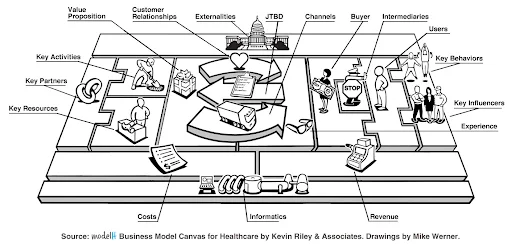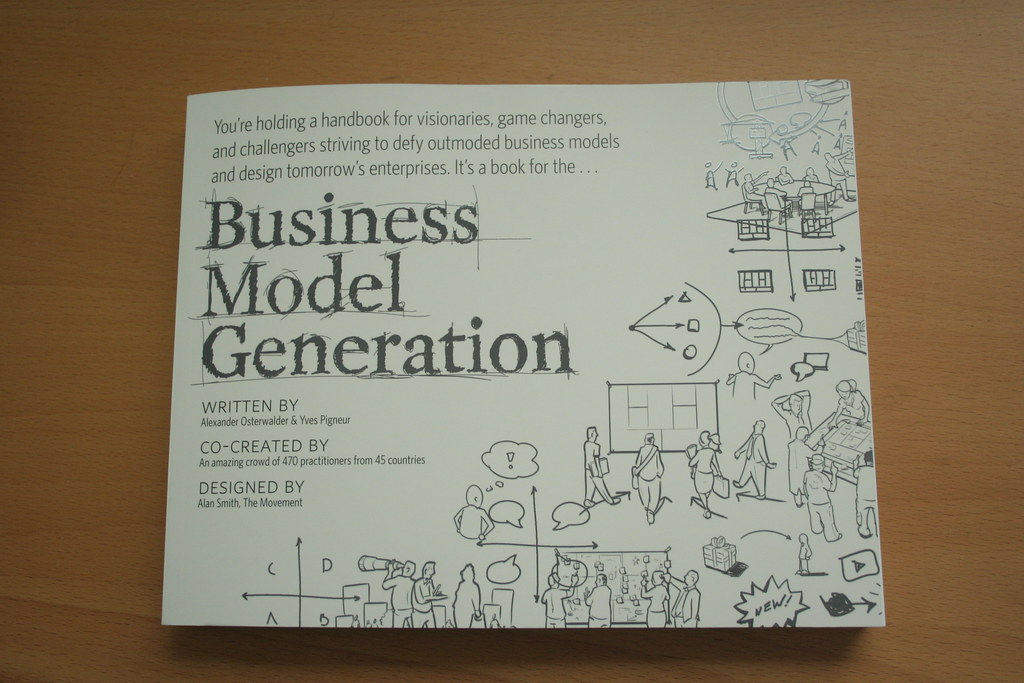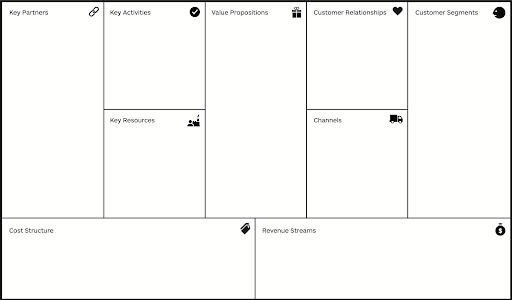
A Business Model Canvas (business model canvas) is a 1-page business model template to help you create a business model for new or existing businesses.
The model is designed to cover all 9 elements of the business and to show the relationships between the parts.
The original Business Model Canvas was published by Swiss business theorist Alexander Osterwalder when he was studying business models for his thesis.
And his research has resulted in a book translated into several languages, Business Model Generation.

Since then, many modifications and versions have become available, similar canvas has been created for almost every sub-market, niche, and very often this technique is used in agile product development. Apart from the original, perhaps the other most popular is the Lean Canvas by Ash Maurya, which specialises in startups. The disadvantage is that it cannot be used for non-profit companies.
But what can the business model canvas help with, what elements does it consist of? And most importantly: how to make a business model canvas?
Benefits of the Business Model Canvas
One of its main advantages is its simplicity.
It is important for all managers to understand and understand the business model of a company. And the easiest way to do this is visually, with as little unnecessary information as possible, even on a single small canvas.
In contrast to business cases, the Business Canvas Model is relevant and transparent.
Think about it: if, for example, investors had to read through a 100-page business plan for each potential portfolio company, Silicon Valley would be a much more deserted place.
Another huge advantage, besides being easy to eat, is that it's easy to prepare.
No need to formulate sentences, no editing, 100 pages. You can create a canvas in words, even in a few minutes. And this is important because you can see very quickly if the business model is going wrong somewhere. Why write 100 pages if it is obvious after 1 page that the business model is not working?
And third, but by no means least, it can be used for startups in the same way as Lean Canvas.
Elements of the Business Model Canvas
The original, free downloadable model looks like this:

It consists of 9 different elements.
The 9 elements are:
- Key Partners- the most important partners
- Who are they?
- What is your motivation for the partnership?
- Key Activities- the most important activities
- What activities are required for your value proposition?
- Which activities are most important for your distribution channels, customer relations, etc.
- value proposition- what value we offer users
- What is the main value you give to the customer?
- What customer desire do you satisfy?
- customer relationship- relationship with the clients
- What kind of relationship does the client want to have with you?
- What kind of relationship do you want to develop with the client?
- Customer segment- Target Audience
- Who is your most important customer?
- Which audience do you add value to?
- Key Resources- the most important resources
- What resources does your value proposition require?
- Which resources are most important for your distribution channels, customer relationships, etc.
- Distribution Channel- which distribution channel is reasonable?
- Which channels work best? How much do they cost?
- Where can you best reach your target audience and where do you want to be reached?
- Cost- costs incurred
- What are the most costly activities?
- How expensive are the main activities/resources?
- Revenue- income
- What value are your customers willing to pay for?
- How do they pay and how do they want to pay?
The order of completion:
Step 1. You need to figure out in your business model what you want to sell.
The more you know about your product, the better you can differentiate yourself. And this is very important. When you think about your product and value proposition, it's also worth looking at your competitors and coming up with a differentiating message and value proposition that makes your product unique and irreplaceable.
So step 1 is to create Value Propositions in the canvas.
Step 2. Once you know what you're selling, you need to find out who will be the person who needs the product. You need to know everything about them - how old they are, what gender they are, where they spend most of their time, what content they consume - everything!
It is worth bearing in mind that a business can usually have more than one target group, not just 1.
So here you have to fill in the Customer Segment box.
Step 3. The next step is to determine how to get your product to your target audience - so linking steps one and two.
Because you've got to know your target audience in the first step, you know exactly where they spend most of their time. These are the channels you need to grab their attention and show them your product.
You will need to fill in the Distribution Channels section.
Step 4. And when you do, you'll need to figure out how you're going to sell to them again and again. It will always be much easier (and much cheaper) to sell to existing customers than to a brand new, cold audience.
This part of the Customer Relationship is the business model on canvas.
Step 5: The picture is starting to come together. You already know what your product is, how you differentiate it, who you sell it to and where, and how you make the relationship with your customers last.
You have the pieces of the creative process in place, now it's time to put them together and figure out what customer journey you're taking the customer on.
Then you put the details together and get a step-by-step idea of exactly how the business's revenue will flow in.
So here you have to fill in Revenue Streams, and this is where you move from creative processes to analytical processes.
Step 6: On paper, the process of making a profit is already clear - then comes the reality!
The practical implementation of the first five steps will give you the key activities, which in fact map out the day-to-day operations of a company.
You need to fill in the Key Activities box.
Step 7: The previously defined step is now part of the practical implementation, which will have a very high cost implication. It may be time or it may be money.
So here you need to define exactly how you want to implement the actions described in step 6, and what resources you will need to do so. This could be hiring people, outsourcing, or anything that takes money or time. The point is that here you are only defining the resources, not the cost.
So in step 7 you need to fill in the Key Resources.
Step 8: In the previous section, you learned what will be required for everything you are about to build.
In most cases, you will not have the resources to do this. And that's not a problem, because that's where the partners come in!
You'll have to outsource some things, because it's best if the key activities are always done by the person who knows best. However, it is very important that if you are outsourcing something out of your own control, you find the best partner to do it with.
The corresponding section is the Key Partners box in the business canvas.
Step 9: You already know practically everything:
- What you will build
- For whom
- How to
...but one question remains unanswered: how much will all this cost?
This is where the circle comes full circle, it will determine whether or not you should start the business and whether or not you will generate enough income.
This should be recorded in the Cost Structures section.
And here comes the biggest advantage of the business model canvas!
This order is by no means set in stone. The logic from the conception of a business to its implementation follows roughly the same logic - but there are at least as many exceptions!
We may already have something that is included in the canvas business model. For example, as a marketer, it's quite likely that we know the channel part perfectly well because we spend most of our time on social media marketing - and we know who we want to sell to.
In this case, we will fill in the Channels and Customer Segments sections, and based on these, we will try to find a product that solves a pressing problem for the selected target group and can be perfectly marketed on the social media channels we are familiar with.
Summary
The business model canvas is one of the world's most popular business model "planners". Used by companies such as Microsoft, Mastercard, Intel, 3M. No wonder, it's incredibly simple, very visual - and freely customizable. Although it has a fill-in order, this can be completely overridden depending on what elements of the 9 are given to the person filling it in.

 Designabc
Designabc